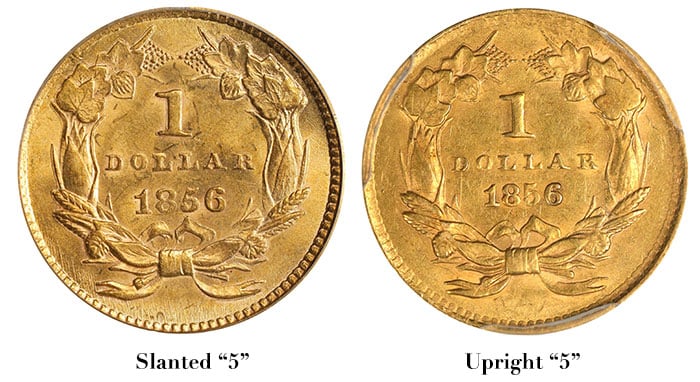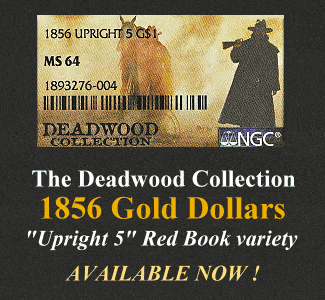
After 24 years of research and competitive buying, collector Craig Krueger is ready to part with “The Deadwood Collection” of Gold Dollars
* * *
By CoinWeek …..
Collector Craig Krueger’s relationship with the 1856 gold dollar began in 1997. A collector his entire life, Krueger took the advice of a leading dealer, who told him to narrow his focus by specializing in an area that struck his interest. And narrow his focus he did. Taking stock of the market for classic U.S. gold coins, he found gold dollars to be underappreciated and undervalued – especially the 1856 gold dollar with the “Upright 5” date style.
In 1856, the United States Mint struck gold dollars with two distinctly different date logotypes. The “Slanted 5” variety, which is the much more frequently encountered version, features an italicized 5. This had been the style employed by the Mint through the first six years of the 1850s. The other style, “Upright 5”, cut a more up-and-down figure.
Krueger was curious as to why the Mint had produced 1856 gold dollars with two date styles and wondered why there was little price spread between them despite the fact that the “Upright 5” was far more elusive. His hunt for answers took him to the collection of the American Numismatic Society, the back vault of the National Numismatic Collection at the Smithsonian, and the National Archives. Krueger also turned his attention to online auctions, where he began to scour listings on Teletrade, eBay, HA.com, and StacksBowers.com. In time, his collection grew to over 150 pieces. So dialed in to accumulating every example that came to market, Krueger had succeeded in nearly cornering the market on a Red Book variety.
Having nearly 50-60% of the surviving population of the variety (per Krueger’s estimation) gave him the opportunity for further research and study. In June 2002, Krueger and noted expert John W. Dannreuther produced an article for The Numismatist titled “A New Slant on Coins of 1850-56”, in which the two posited their belief that the appearance of the upright date logotype towards the end of 1856 was the result of an effort to standardize the dates on all U.S. coins. They also put forward evidence that the “Upright 5” was produced after the “Slanted 5” variety – a position that is supported by the complete shift away from italicized numerals on all U.S. denominations starting in 1857. The quality of research undertaken to produce the article earned the pair the ANA’s prestigious Wayte and Olga Raymond Memorial Literary Award.

According to Krueger, the way the numismatic community viewed the “Upright 5” was wrong.
“The coins tell the story about the standardization of a date style and the Mint’s efforts to combat counterfeiting in the 1850s.”
Krueger’s deepening understanding of the variety also led him to write a follow up piece about the variety, which was published in the The Numismatist in 2005. In the piece “Making the Grade: The 1856 “Upright 5” Gold Dollar”, Krueger approximated the relative scarcity for the variety, citing opinions from leading numismatists and his own observations. According to Krueger’s research, the Mint likely struck no more than 75,000 examples of the Upright 5. A paltry sum compared to the 1,687,936 coins that were likely struck using dies with the italicized date.
In truth, these market inefficiencies exist throughout the numismatic landscape when commercial interests precede numismatic discovery. But Krueger’s position is somewhat analogous to the landscape of 1873 coinage before collector Harry X Boosel promoted and popularized the Closed 3 and Open 3 varieties of United States coinage.
The varieties of “Upright” and “Slanted” 1856 coinage follow a similar pattern but were created 17 years earlier. Both the gold dollar and the Braided hair one-cent coin, which was also struck at the Philadelphia Mint, were produced with distinctly different date styles.

Why Did America Need a Gold Dollar?
Simply put, the California Gold Rush set the stage for the introduction of not one, but two new U.S. gold denominations: the dollar and the double eagle ($20 gold coin).
Commercial production of gold was underway in the California Territory as early as 1842, after Mexican mineralogist Don Andres Castillero discovered a deposit of pyrite (“fool’s gold”) during an excavation at Las Virgenes Rancho. After showing his find to a gathering of friends in Santa Barbara, Francisco Lopez, the majordomo of Mission San Gabriel, discovered a small deposit of placer gold in Piru Rancho.
Mexican control of the California Territory became contested with the outbreak of the Mexican-American War and the fact that English-speaking settlers had flooded into the area and rebelled against Mexican authorities. Soon thereafter, the US Navy took the lead role in America’s conquest for the coastal territory. Meeting little resistance, hostilities ended in January 1847 with the Treaty of Cahuenga. A year later, James W. Marshall famously discovered gold at Sutter’s Mill, setting off the largest gold rush in American history.
The gold dollar was a button-sized coin measuring 13 millimeters and weighing 1.62 grams. Each coin contains 0.4837 ounces of pure gold.
The denomination was struck in quantity at the Philadelphia Mint and to a much lesser extent at the branch mints in Charlotte, Dahlonega, and San Francisco. Five Philadelphia issues were struck in excess of one million pieces, but this would not prove to be the norm as the denomination fell out of favor following the Civil War. Production at the branch mints was paltry, where the typical output seldom eclipsed 15,000 pieces.
The denomination was discontinued in 1889 and only resurrected for a few commemorative issues in the early 20th century.
When the gold dollar was produced for circulation, it was struck in three styles. The first style (Liberty Head) was issued from 1849 to 1854. The second type (the “Indian Princess“) was struck from 1854 to 1856, with the San Francisco Mint being the only mint to strike this style in 1856.
The third type, featuring a larger Indian Princess Head was struck from 1856 to 1889. This style is commonly referred to as the Type Three Gold Dollar.
The Gold Dollars of 1856: Two Types and Two Date Styles
The San Francisco Mint’s 1856 gold dollars were produced using Type Two dies. All Philadelphia Mint issues of 1856, both the “Slanted 5” and the “Upright 5”, were struck using the new Type Three dies.

In total, the Philadelphia Mint struck 1,762,936 gold dollars in 1856. This total combines the mintages of the “Slanted 5” and the “Upright 5” varieties. Krueger and Dannreuther posit that the Mint likely produced the “Upright 5” in the fourth quarter of 1856, after exhausting their supply of dies produced with the “Slanted 5” date style. The fact that the italicized 5 disappears in 1857 gold dollar production provides convincing backup to his claim. As for why the change happened, Krueger believes that the Mint changed the date style to combat the scourge of counterfeits.
Mintage and survival estimates for the variety are impossible to know for sure. Absent Mint records (which, even if they existed, may not be entirely accurate), one is left to look at the data and make assumptions. J.P. Martin and David Akers did just that and estimated that the “Upright 5” was between five and 15 times scarcer than the “Slanted 5”.
None of these experts had access to the quantity of “Upright 5” gold dollars that Krueger had accumulated. When Krueger and Dannreuther studied the coins, they determined that the Upright 5 dollars were struck using only two dies, making the variety much scarcer than previously believed.
Compounding the problem is the unreliability of the population data reported at both PCGS and NGC. According to Krueger and Dannreuther, in the past, neither firm consistently differentiated between the two date styles when encapsulating coins. Part of this was due to expediency, and part was due to the profit motive. Having a variety designation on a coin holder was a premium service that came with an additional fee. Without a clear differential in value between the two varieties, many dealers chose not to pay for the attribution. In time, the services made differentiating the two date styles part of their standard service, and the current population data, as flawed as it might be, suggests a nearly 5:1 ratio for Slanted to Upright 5s in PCGS and NGC holders.

Of course, the total number of gold dollars left that have not been submitted for grading is unknown.
The elusiveness of the Upright 5 has not gone unnoticed by other dealers who specialize in classic U.S. gold. In a 2001 blog post, dealer Doug Winter placed the MS64-graded 1856 Upright 5 first on his list of “Ten Undervalued U.S. Gold Coins Under $2,500”. Winter cited the small differential in price between MS64 examples of the two date styles. He believed at the time that the grading services were not representing the true scarcity of the Upright 5 in their population reports.
The Deadwood Collection Comes to Market
Now that his journey with the 1856 Upright 5 is drawing to a close, Krueger has set out to present his favorite coin to collectors in a package that captures the imagination.
 The coins are stored in South Dakota, where Wild Bill Hickok, Calamity Jane, and Buffalo Bill ruled, and like California, Deadwood, too had its own gold rush.
The coins are stored in South Dakota, where Wild Bill Hickok, Calamity Jane, and Buffalo Bill ruled, and like California, Deadwood, too had its own gold rush.
The coins have been certified by NGC, and many of the finer ones have been CAC-approved.
Krueger says, “I hope that other numismatists will take up where I left off and break new ground on researching and popularizing this variety. It’s a much tougher coin to find than people think.”
A limited number of coins will be on display in Chicago at the 2022 World’s Fair of Money at dealer Julian Leidman’s booth. Some of the finer pieces will likely head to auction.
Of the Deadwood Collection, Krueger promises that while limited in number, there may be a coin for every budget.
“I just wanted to know more about the variety. I collected circulated examples, details grade examples, and most of the pieces that survived in Mint State.”





Fascinating history. This part needs an edit: “The gold dollar was a button-sized coin measuring 13 millimeters and weighing 1.62 grams. Each coin contains 0.4837 ounces of pure gold.”